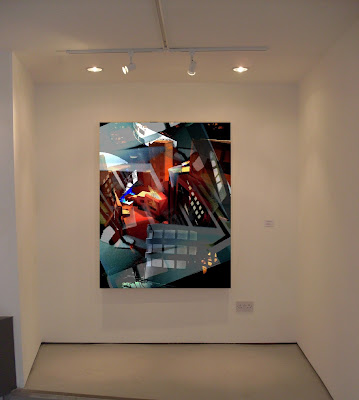 Christopher Richard Wynne Nevinson (13 August 1889 – October 1946) was a British figure and landscape painter, etcher and lithographer. He is often referred to by his initials C. R. W. Nevinson, and was known as Richard.
Christopher Richard Wynne Nevinson (13 August 1889 – October 1946) was a British figure and landscape painter, etcher and lithographer. He is often referred to by his initials C. R. W. Nevinson, and was known as Richard.
I find Nevinson interesting because of the quality of light in his artwork. He painted in a very cubist/ futuristic style and his work often included cities which is where my project is set.
My first impressions of his work were that the work was quite dramatic. The paintings often showed scenes from the war period and were almost like a memorial to those who have fallen in the war.
Where my interest lies is the overall atmosphere he created in his work. The mood I see in his artwork feels the same as the one from Whistlers and Nicholas Wright's work. The scenes he created are very moody and pull the viewer in quite well. Just as with the other artists, you don't focus on the contents of the painting as much as you do on the quality of the light.
Another thing I like about his work is the depth in some of the pieces. The painting to the left is called 'The soul of the Souless city' (New York - 1920). "Nevinson painted this picture when he returned to London. The painting shows an imaginary section of the elevated railway running through Manhattan. The railway line recedes dramatically into a cluster of skyscrapers. The angular shapes and muted brown and grey colours suggest the speed and technology of the modern city"
This painting reminds me of some of the streets in Piccadilly Circus from which I photographed and looking back to it, it looks very similar to this artwork.
As a response to the artist, I produced an abstract Photoshop piece. I used various techniques and processes such as layering multiple images and cropping, rotating and resizing parts of them to fit on the background. Nevinson created those tall structural pieces and I wanted to try doing something in that style, but with my own influence. I used my installation images to produce this response.
When working on Photoshop, I made sure to look back at the artists work to get the mood that image captures. It makes you feel overwhelmed by the structures surrounding you so what I did was used a small figure at the front to create a perspective of someone looking at the buildings as if they were standing there. I used duplicating to create multiple small structures all around the figure to capture this strong feeling of being overwhelmed by buildings.
Light is very important for me in this project so I used various contrasts and brightnesses while experimenting and then combined them into this single response. I was able to capture several moods and then combine them ins a single Photoshop piece. The artist did a similar thing, but he didn't combine different images and instead he used different settings and combined them while maintaining balanced light throughout the piece. I wanted to push what the artist has already done with different settings and use various settings of my own in a single piece, but each having their own mood and atmosphere.
As a response to the artist, I produced an abstract Photoshop piece. I used various techniques and processes such as layering multiple images and cropping, rotating and resizing parts of them to fit on the background. Nevinson created those tall structural pieces and I wanted to try doing something in that style, but with my own influence. I used my installation images to produce this response.
When working on Photoshop, I made sure to look back at the artists work to get the mood that image captures. It makes you feel overwhelmed by the structures surrounding you so what I did was used a small figure at the front to create a perspective of someone looking at the buildings as if they were standing there. I used duplicating to create multiple small structures all around the figure to capture this strong feeling of being overwhelmed by buildings.
Light is very important for me in this project so I used various contrasts and brightnesses while experimenting and then combined them into this single response. I was able to capture several moods and then combine them ins a single Photoshop piece. The artist did a similar thing, but he didn't combine different images and instead he used different settings and combined them while maintaining balanced light throughout the piece. I wanted to push what the artist has already done with different settings and use various settings of my own in a single piece, but each having their own mood and atmosphere.
Links to other artists
I think this artist links back to my other artist Nicholas Wright. Both artists created those massive cities and create a very moody atmosphere that pulls you into the artwork. Both artists created depth in their works which allows the viewer to truly explore the piece.








.jpg)




















